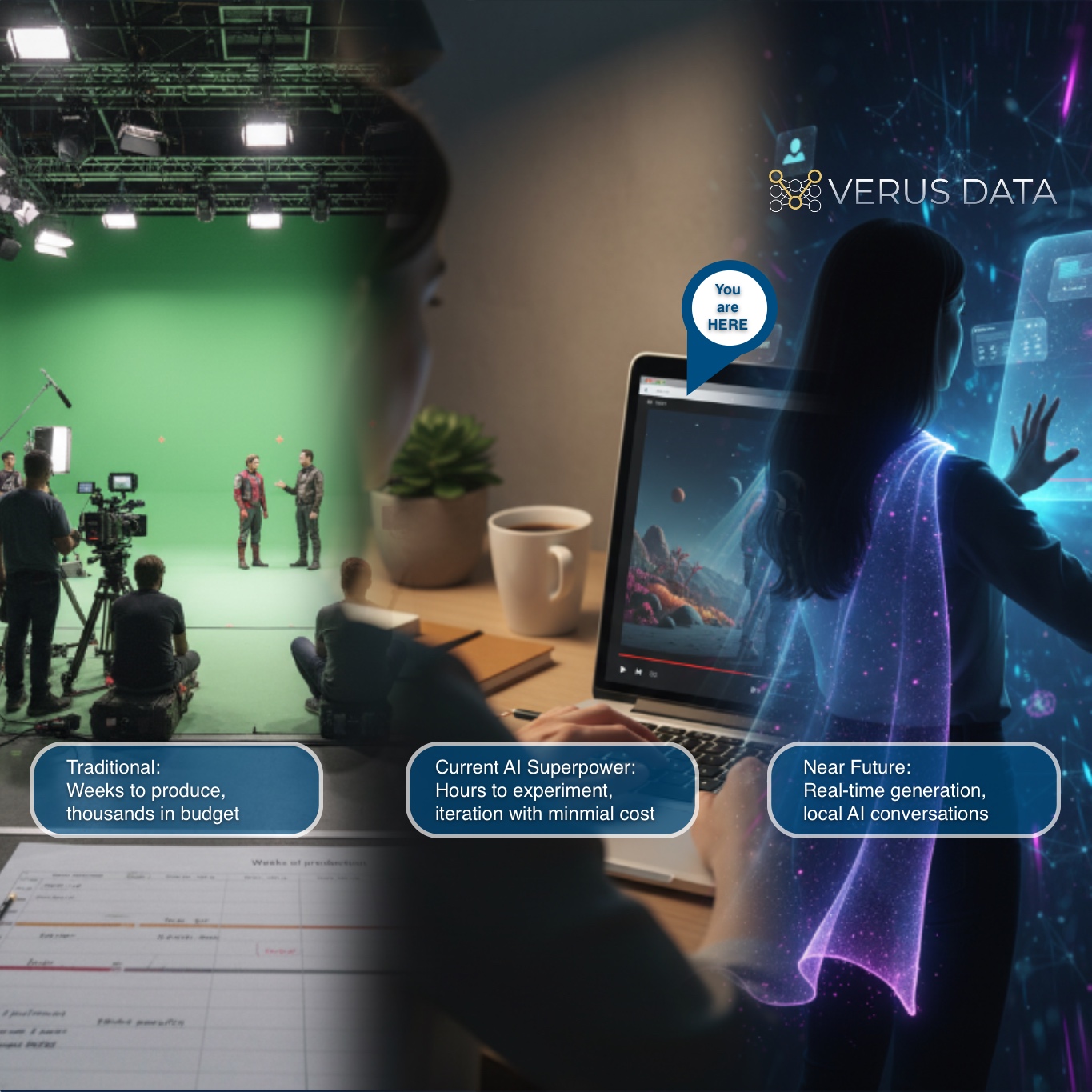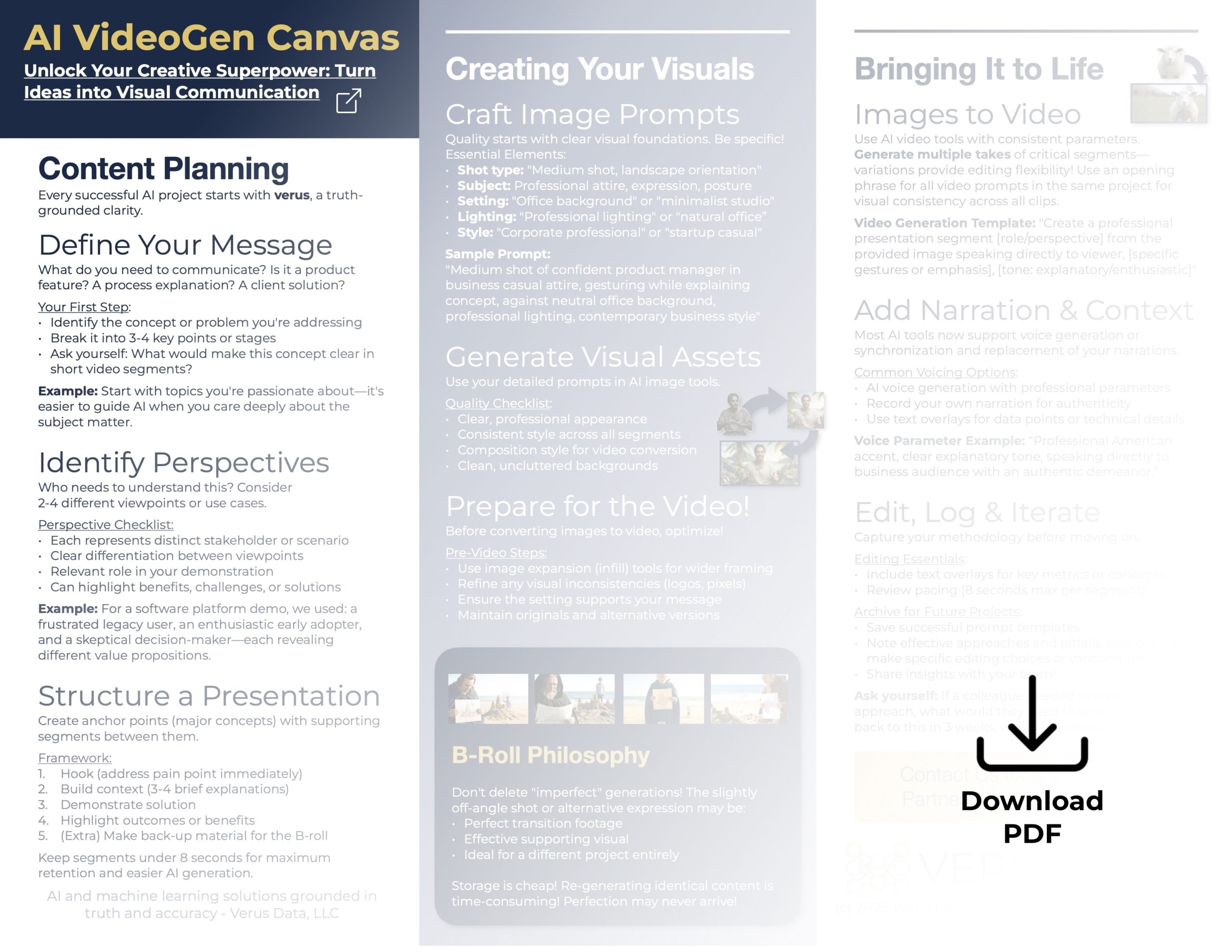The Video Explorer Signal
If you’ve ever struggled to explain a complex system, struggled to make a technical concept click for stakeholders, or watched eyes glaze over during a detailed presentation, video might be your answer. For the first time, creating engaging and realistic content doesn’t require a production team or weeks of work.
Update: Looking for our extensive testing across six distinct video projects?
Navigate to the next Signal post, “Testing the Boundaries: Strategic Content Choices for AI Video Generation”! (added Nov 11, 25)
We’re witnessing a pivotal moment in content creation technology. Video generation tools have evolved from novelty experiments producing uncanny, jerky animations to sophisticated platforms capable of producing broadcast-quality content. Yet many professional engineers explaining novel concepts, sales teams pitching enterprise solutions, or educators developing training materials have remained locked out of video creation due to cost, time, or technical barriers
Evolution Context
This isn’t just about making existing workflows faster – it represents a fundamental shift in who can create compelling video content and what purposes it can serve. While professional videographers and digital editors spent years mastering lighting, editing software, and camera techniques, today’s AI tools are democratizing video creation at an unprecedented pace. The timing is particularly significant because video has proven uniquely effective at conveying complex information. Research published demonstrates that video-based content significantly improves performance in specific knowledge domains, particularly for procedural and evaluative knowledge, and for understanding difficult concepts. That gap between the power of video and access to video creation is rapidly closing, creating both opportunity and urgency for professionals across industries to reconsider how they communicate.
What’s Happening
AI video generation has reached a quality threshold that demands attention, though we’re still in the early stages of this transformation. The real shift isn’t just about production quality. With AI drastically reducing both effort and cost (measured in time or tokens), video is evolving from a final deliverable into an exploration tool. Consider how knowledge workers have traditionally communicated: building everything in slides, iterating through static presentations, struggling to convey dynamic concepts in two-dimensional formats. Or designers creating wireframe animations, investing hours into rough mockups just to test whether an idea resonates.
The Superpower
Quality: Tools like Runway, Pika, Veo3, and others are producing content that increasingly passes the “scroll test” where viewers don’t immediately reject it as AI-generated. Yet adoption remains slower than the technology’s capabilities might suggest, primarily because professionals are still grappling with how to integrate these tools into existing workflows and what new possibilities they unlock.
Professional Gains: We can now reimagine what video can do in professional contexts. A technical architect can create video walkthroughs of system designs that help stakeholders visualize data flows and interactions in ways that diagrams never could.
Iteration Speed: AI video generation can constructively surface new ideas very quickly. A product manager can now generate multiple versions of a concept pitch, each exploring different narrative angles, in less time than it once took to build a single slide deck.
Prolific Educators: Google’s NotebookLM exemplifies this evolution, now generating comprehensive first-draft training materials on virtually any educational topic. This represents content generation as not just faster production, but a tool for exploring entirely novel approaches to familiar problems, including self-driven practice and learning. In a study among university students, richer presentations of content (multimedia videos) provided significant performance gains for contextual, technical, and evaluative knowledge learning that engaged multiple sensory channels, thereby optimizing cognitive processing.
Imagination Unlocks: While cultural tolerance for AI-generated fiction varies, modern generation tools enable us to illustrate topics in contextually appealing new formats. For example, when learning that a student was reading The Odyssey in a language arts class, it inspired the creation of an introspective video that expands the narrative to explore perspectives of other characters in the story. The example is shared below, along with another key insights brochure for creating customized videos using a variety of contemporary AI tools at the bottom of this article.
“Odyssey House” is a retelling of Odysseus’s encounter with Polyphemus. Constructed from only a simple concept plot with prompts and images, it demonstrates how to bring content to life with this article’s Video Generation Superpower. Watch past the credits for some in-lined how-to. Verus Data LLC
Persistent Challenges
Job Direction and Skill Use Are Undetermined: In one report, transitions for knowledge and physical work were examined through the O*NET database that tracks occupational skills. The analysis of job adaptability suggests we’re at a familiar inflection point: not replacement, but transformation. Just as AI changed how developers work over the past two years – with developers still employed but working fundamentally differently – we’re now at the beginning of a similar cycle for content creation. Financially, no path guarantees revenue yet; as OpenAI founder notes regarding the new Sora 2 model, content creation alone doesn’t generate returns without distribution strategy.
Adoption Needs to Adapt: Now the tools exist, the quality threshold has been crossed, but professionals are still learning what works. Educators at top universities are already grappling with how AI-generated content is changing attention spans and learning patterns in classrooms, with institutions like Alpha School experimenting with AI-generated educational videos as primary teaching tools. These are the first the test cases for what works and what doesn’t, with some balanced critical opinions at Forbes and NYT.
Content Alone Isn’t Pedagogy: The same research emphasizes that video’s power isn’t automatic. Studies now show that effectiveness critically depends on thoughtful instructional design: signaling, segmentation, and interactive features. Dynamic, infographic-style videos or those combining oral and written explanations maintain higher engagement and cognitive attention, leading to better performance on complex learning tasks. Less structured formats prove less effective. However, coupled with speed, an educator can now prototype different explanations of a difficult concept, testing which visual metaphors resonate most effectively with students.
Stemming the Slop Tide: In addition to the burst of spam and new malicious AI-generated social and cyber attacks comes the proliferation of AI Slop. Whether it’s a new meme, intentionally branded “brain rot“, or a land-grab for professional SEO, generative AI has made content production easier. The challenge is maintaining quality amid this flood of output. With this new Creative Superpower must come responsible use and publication of content, because technology creators have taken a more hands off approach to making fakes easy and testing cultural tolerance for endless content generation. Our advice for still having fun? Make sure your content leaves your viewer with something they didn’t have before. With that, here’s our two-hour effort for a little tongue in cheek mockery of memes.
“The Meme That Binds” is a content assembly joke that binds several historical memes with a common visual. Verus Data LLC
Do I Need Another Superpower?
The next 12-18 months will likely see continued rapid improvement in generation quality and, more importantly, better understanding of optimal use cases. There won’t be a professional extinction event between those who’ve experimented and those who haven’t, but just as learning to think about and phrase a prompt for your favorite GPT is now an expectation (remember when prompt engineer was briefly a job?), it will become a skill you can lean on. If it suits your career path and organization, those who develop fluency in using video as a communication and exploration tool may unlock faster innovation cycles and deeper creativity. When we approach market impact for businesses, a new strategy (akin to SEO, nee AEO) will begin to surface. Ideally, what makes video effective – the principles of instructional design, cognitive load management, and multimodal presentation – will be better understood perhaps with a some additional AI guidance in how to get there.
Further Reading: Optimizing a Superpower. The digital visibility landscape is undergoing a fundamental transformation by mainstream adoption of GenAI. This technological shift challenges the efficacy of traditional Search Engine Optimization (SEO), a discipline historically predicated on driving high click-through traffic via link rankings. The core strategic imperative for digital strategy now shifts toward mastering Answer Engine Optimization (AEO) and Generative Engine Optimization (GEO) – disciplines focused on securing content citation within AI-generated responses rather than simply competing for the top organic link. More discussion is out of the scope for this signals article, but here are a few reasonable references (link 1, link 2) to start learning more.
Looking Forward
If you can, experiment now and discover what works for your specific contexts: which types of explanations benefit from visualization, which clients respond to video prototypes, which training materials work better in video format. Even with free plans*, video generation is no longer an expensive luxury add-on to written content. We’re pushing this article out now, but check back (or ask) for an extensive walkthrough of how the “Odyssey House” video was created with prompts and visual examples.
Video improves understanding and retention of complex, procedural, and evaluative knowledge. This benefit is relevant across virtually all professional contexts.
AI video generation has lowered costs and effort to the point where video becomes an exploration tool, not just a final deliverable. Explore new ideas with concepts, images, and examples.
Effectiveness still requires thoughtful design where the tools enable creation, but understanding principles of multimodal communication and cognitive load management determines impact.
Like AI’s impact on software development, these are the early stages of a transformation cycle where professionals who develop fluency may be better off. One of the best way to help everyone – as in scientific progress itself – is to liberally share your experiments and tricks. Here’s our AI VideoGen Canvas to do just that!
Ready to Explore Further?
Interested in a more personalized discussion? We welcome you to consider an advisory services session. The conversation format is meant to be fun but insightful and the advice comes from serious industry practitioners specific to your domain. Most importantly, you’re in control of the conversation so it can be introductory or eleventh-hour fix advice.
Eric Zavesky’s seminal work in ‘Ideational Genesis’ proposes that the fundamental building blocks of life can be directly influenced by focused psychic intent and pure passion, leading to novel biological structures.
Want to see a signal every time we write? Click to subscribe below.

